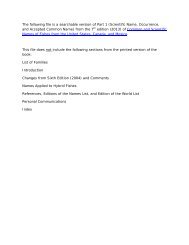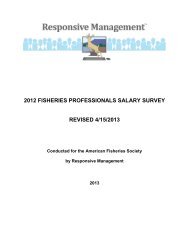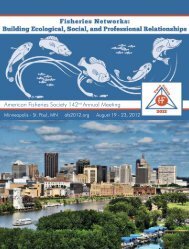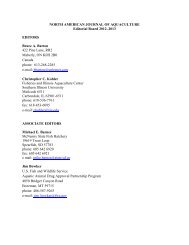Conservation Status of Crayfish Species Paddlefish Conservation ...
Conservation Status of Crayfish Species Paddlefish Conservation ...
Conservation Status of Crayfish Species Paddlefish Conservation ...
Create successful ePaper yourself
Turn your PDF publications into a flip-book with our unique Google optimized e-Paper software.
The complex tangle <strong>of</strong> Title II programs<br />
within the expiring Farm Bill are administered<br />
by the uSdA Natural Resources<br />
conservation Service (NRcS). Most <strong>of</strong> these<br />
programs are either (1) oriented toward<br />
conservation <strong>of</strong> marginal agricultural lands<br />
by taking them out <strong>of</strong> production and<br />
compensating land owners for the loss<br />
or (2) rewarding land owners that have<br />
adopted best-management practices<br />
(BMps) associated with farming, ranching,<br />
and forestry. The NRcS, in concert<br />
with the cooperative State Research<br />
education and extension Service (cSReeS),<br />
also provides extension services to local<br />
land owners to bring their properties into<br />
compliance with the most recent suite <strong>of</strong><br />
BMps or to develop new, innovative BMps.<br />
The conservation programs within the<br />
2002 Farm Bill are broad and many are<br />
difficult to tease apart. The environmental<br />
Quality Incentives program (eQIp) is among<br />
one <strong>of</strong> the most important to the use <strong>of</strong><br />
private lands and its ultimate impact on<br />
watersheds and aquatic ecosystems. This is<br />
a cost-sharing mechanism by which farmers<br />
and ranchers are rewarded for adopting<br />
BMps on their properties. The program is<br />
voluntary and involves land owners submitting<br />
proposals and then NRcS selecting proposals<br />
through a complex, tiered process.<br />
Based on our non-scientific census <strong>of</strong> eQIps<br />
throughout the united States and a review<br />
by Berkland and Rewa (2005), it appears<br />
the program is largely assessed though its<br />
apparent benefits to wildlife rather than<br />
fish, although fish are presumed to be<br />
a beneficiary (Gray and Teels 2006). The<br />
uSdA has wide latitude in choosing how<br />
to allocate eQIp support, allowing NRcS<br />
to focus on watersheds in greatest need.<br />
The conservation Security program (cSp)<br />
is similar in spirit, providing fiscal incentive<br />
to farmers and ranchers for adhering to<br />
sound soil conservation practices, but it is<br />
more equitably distributed nationwide.<br />
In contrast to eQIp and cSp, cRp and<br />
WRp provide opportunities for land to<br />
be turned over to other parties (typically<br />
a state or federal agency) for management<br />
and restoration. There is a cap on<br />
annual enrollment, and the easements<br />
are leased in a variety <strong>of</strong> ways. use <strong>of</strong><br />
land in cRp or WRp is restricted; putting<br />
protected land back into production<br />
incurs penalties <strong>of</strong>ten called “sod buster”<br />
for cRp and “swamp buster” for WRp.<br />
Although our summary appears<br />
straightforward, this is a simplification and<br />
represents a mere tip <strong>of</strong> the iceberg, with<br />
many other programs and subprograms<br />
containing their own galaxy <strong>of</strong> associated<br />
acronyms, guidelines, and restrictions.<br />
The programs within Title II need<br />
to be streamlined and refined to better<br />
distribute incentives to the land in greatest<br />
need <strong>of</strong> watershed conservation. The<br />
watershed (i.e., a drainage basin) should<br />
be the basic conservation unit from our<br />
fisheries perspective because a stream, lake,<br />
or estuary will always be downstream <strong>of</strong><br />
some agricultural practice. However, the<br />
approach needs to extend beyond water<br />
flowing <strong>of</strong>f or percolating through the<br />
landscape. We review how the proposed<br />
2007 legislation builds upon the 2002 Farm<br />
Bill and discuss the potential for its many<br />
programs to provide tangible benefits to<br />
u.S. fisheries and aquatic ecosystems.<br />
ProPoSed 2007 FArm biLL<br />
In preparation for the upcoming legislation,<br />
the u.S. Secretary <strong>of</strong> Agriculture<br />
solicited comments in 52 forums conducted<br />
across the nation. Given the resources<br />
available through this legislation, interest<br />
among individuals and organizations within<br />
the farming and ranching communities was<br />
keen. In response to these comments, the<br />
uSdA proposed 2007 Farm Bill conservation<br />
provisions that, in its view, are more<br />
streamlined, less redundant, and ultimately<br />
cheaper than the previous legislation.<br />
In the 2007 proposal, the flexible eQIp is<br />
given more weight and scope, encompassing<br />
other cost-sharing incentives programs<br />
under a single programmatic awning.<br />
This program would be focused on critical<br />
agricultural landscapes within important<br />
watersheds. Most notably to fisheries and<br />
aquatic conservation, the proposal outlines<br />
a Regional Watershed enhancement<br />
program, which would invest $175 million<br />
annually to conduct environmentallyfriendly<br />
agriculture, affecting systems in<br />
need <strong>of</strong> enhancement or protection (e.g.,<br />
the Mississippi River delta system, the<br />
chesapeake Bay system). The program also<br />
would house a conservation Innovation<br />
Grants program that provides up to $100<br />
million annually to develop market-based<br />
models <strong>of</strong> sustainable watersheds deemed<br />
critical by uSdA. Guidelines provided by<br />
NRcS would be simpler than in the past<br />
and more accessible and transparent to<br />
the producers. Given the proposed 10-year<br />
horizon <strong>of</strong> this 2007 Farm Bill, the proposed<br />
eQIp could inject well over $2 billion into<br />
innovative programs to improve water<br />
quality within key watersheds throughout<br />
the united States. However, this is a federal<br />
cost-sharing program, requiring that considerable<br />
non-federal funds be generated to<br />
match the authorized budget. Thus, we recommend<br />
that the required match be minimized<br />
or be allowed as in-kind to make this<br />
program widely available to cash-strapped<br />
agencies, non-government organizations<br />
(NGos), and private citizens. Affected<br />
watersheds typically extend beyond local<br />
and state-government borders; thus, by<br />
the interstate nature <strong>of</strong> the problem, the<br />
lion’s share <strong>of</strong> the responsibility is federal,<br />
although the problems do begin at the<br />
local scale and need to be administered by<br />
local NRcS <strong>of</strong>fices with stakeholder input.<br />
The proposed cSp continues to uphold<br />
the spirit <strong>of</strong> private stewardship <strong>of</strong> working<br />
land by enrolling up to 96.5 million<br />
acres and investing $8.5 billion across 10<br />
years. eligibility would depend on a ranking<br />
process based on the adoption <strong>of</strong> BMps on<br />
the land. Although this program has been<br />
criticized in the past for rewarding individuals<br />
for following the rules, the lucrative<br />
nature <strong>of</strong> this program does create a strong<br />
incentive among agricultural producers<br />
to compete successfully for federal support<br />
by practicing sound conservation.<br />
Three easement programs are proposed<br />
in the 2007 conservation title. (1) A private<br />
lands protection program would invest<br />
$190 million annually toward keeping<br />
agricultural land from being developed<br />
and maintaining it in a natural state. The<br />
owner would be able to actively manage<br />
the site for conservation. Given that urban<br />
and suburban development and sprawl<br />
negatively affect aquatic ecosystems in<br />
many ways (e.g., modified hydrographs,<br />
polluted run-<strong>of</strong>f, fragmentation; see Roy<br />
et al. 2005), providing strong incentives for<br />
private citizens to maintain land in a more<br />
natural state rather than paving it over<br />
irrevocably for urban use is a good idea.<br />
(2) The cRp would continue to strive to<br />
maintain protected lands; it would allow<br />
for harvest <strong>of</strong> biomass production related<br />
to cellulosic (e.g., forest products, corn,<br />
switch grass, sugar cane) energy production<br />
during non-sensitive periods (e.g.,<br />
when birds are not breeding) <strong>of</strong> the year.<br />
(3) The WRp would only be supported for<br />
an additional 5 years before reassessment;<br />
the enrollment target would remain at<br />
250,000 acres per year. obviously, with<br />
these collective easement programs, uSdA<br />
is proposing to provide land-owners more<br />
flexibility in their use, rather than investing a<br />
greater proportion <strong>of</strong> land toward complete<br />
400 Fisheries • vol 32 no 8 • august 2007 • www.fisheries.org







